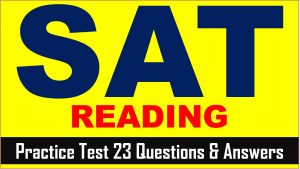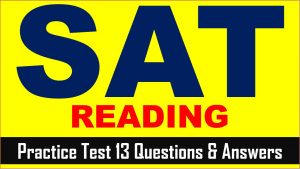SAT (Scholastic Assessment Test) is a standard test, used for taking admission to undergraduate programs of universities or colleges of the United States. SAT is developed and published by the College Board, an organization in the United States, administered by the Educational Testing Service. In this article of AKVTutorials, you will get SAT Reading Comprehension Practice Test 35 | SAT 2024 Online Tutor AMBiPi.
SAT Reading Practice Passage
This passage is adapted from Brian Greene, “How the Higgs Boson Was Found.” ©2013 by Smithsonian Institution. The Higgs boson is an elementary particle associated with the Higgs field. Experiments conducted in 2012–2013 tentatively confirmed the existence of the Higgs boson and thus of the Higgs field.
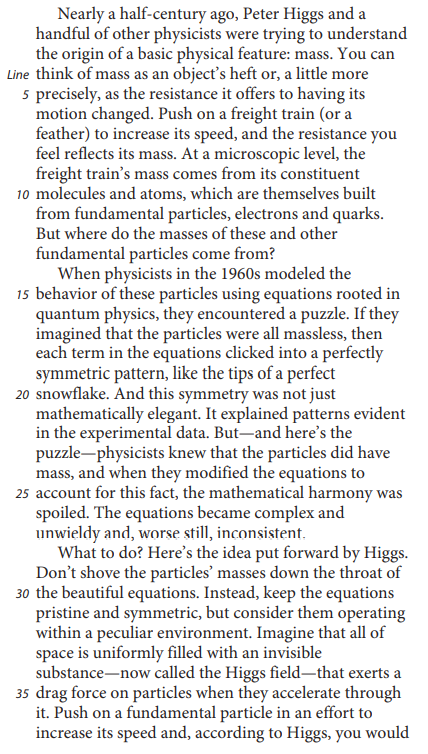
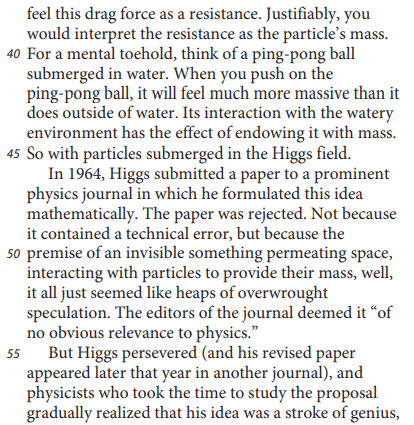
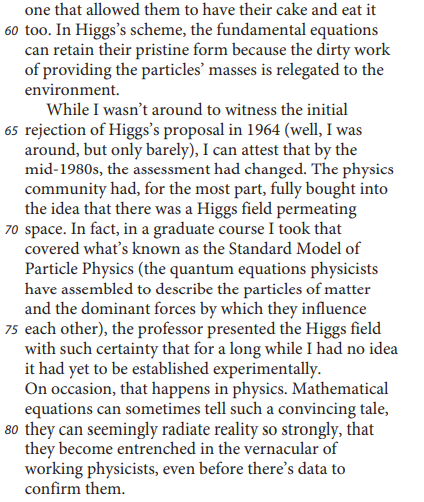
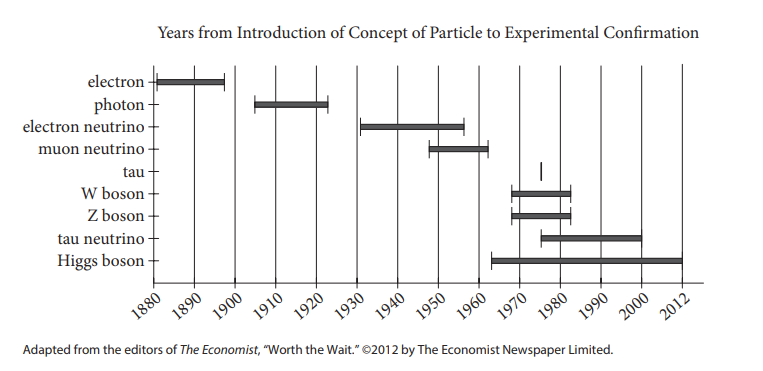
SAT Reading Comprehension Practice Test Questions
SAT Practice Test 35 Question No 1
Over the course of the passage, the main focus shifts from
Option A: a technical account of the Higgs field to a description of it aimed at a broad audience.
Option B: a review of Higgs’s work to the contextualization that works within Higgs’s era.
Option C: an explanation of the Higgs field to a discussion of the response to Higgs’s theory.
Option D: an analysis of the Higgs field to a suggestion of future discoveries that might build upon it.
SAT Practice Test 35 Answer No 1
Show/Hide Answer
Option C :
The passage’s first two paragraphs describe how “Peter Higgs and a handful of other physicists were trying to understand the origin of a basic physical feature: mass,” and the third paragraph discusses the idea put forth (“now called the Higgs field”) to explain the environment where mathematical equations are most helpful in understanding mass. The passage shifts its focus, however: the fourth and fifth paragraphs describe how the idea of the Higgs field was not initially well-received in the scientific community, and the last paragraph illustrates that in modern times, the idea ultimately became an accepted fact to most scientists. Over the course of the passage, then, it can be seen that the main focus of the passage changes from an explanation of what the Higgs field is to an explanation of how the theory of it was received.
Choice A is incorrect because the passage makes no shift from a more to a less technical mode of description, and indeed the entire passage is aimed at readers with no specialized knowledge of physics. Choice B is incorrect because the passage never provides any contextualization of Higgs’s work within other lines of inquiry in physics contemporary to Higgs. Choice D is incorrect because the passage offers no speculation regarding future discoveries that may result from the confirmation of the Higgs field’s existence.
SAT Practice Test 35 Question No 2
The main purpose of the analogy of the ping-pong ball (line 40) is to
Option A: popularize a little-known fact.
Option B: contrast competing for scientific theories.
Option C: criticize a widely accepted explanation.
Option D: clarify an abstract concept.
SAT Practice Test 35 Answer No 2
Show/Hide Answer
Option D :
The third paragraph of the passage provides the following analogy: “For a mental toehold, think of a ping-pong ball submerged in water.” Since this analogy occurs in a discussion of how mass operates within the Higgs field, it functions to explain an abstract concept in terms more readily grasped by readers with no background in physics.
Choices A, B, and C are incorrect because the analogy of the ping-pong ball is used in the passage to help laypeople understand the difficult concept of the Higgs field, rather than to make a little-known fact more widely known (choice A), draw a contrast between oppositional scientific theories (choice B), or refute any established explanation (choice C).
SAT Practice Test 35 Question No 3
The author most strongly suggests that the reason the scientific community initially rejected Higgs’s idea was that the idea
Option A: addressed a problem unnoticed by other physicists.
Option B: only worked if the equations were flawless.
Option C: rendered accepted theories in physics obsolete.
Option D: appeared to have a little empirical basis.
SAT Practice Test 35 Answer No 3
Show/Hide Answer
Option D :
The fourth paragraph of the passage explains why Higgs’s idea of the Higgs field was initially rebuffed by the scientific community: “The paper was rejected. Not because it contained a technical error, but because the premise of an invisible something permeating space, interacting with particles to provide their mass, well, it all just seemed like heaps of overwrought speculation.” In other words, the scientific community was skeptical of Higgs’s idea because it appeared to be mere theoretical speculation, with no empirical evidence to support it.
Choice A is incorrect because the passage makes clear that Higgs’s idea addressed a theoretical problem already recognized by scientists, rather than a problem yet to be noticed by them. Choice B is incorrect because the fourth paragraph implies that Higgs’s paper was rigorous (free from “technical error”), rather than problematic at the level of its equations. Choice C is incorrect because the passage never indicates that the acceptance of the Higgs field had the effect of rendering other, earlier theories in physics obsolete.
SAT Practice Test 35 Question No 4
Which choice provides the best evidence for the answer to the previous question?
Option A: Lines 30-32 (“Instead… environment”)
Option B: Lines 46-48 (“In 1964… mathematically”)
Option C: Lines 48-53 (“Not… speculation”)
Option D: Lines 67-70 (“The physics… space”)
SAT Practice Test 35 Answer No 4
Show/Hide Answer
Option C :
The previous question asks why the scientific community initially rejected the idea of the Higgs field. The answer, that Higgs offered only theoretical speculation for the existence of the field, not actual evidence, is supported in the fourth paragraph: “The paper was rejected. Not because it contained a technical error, but because the premise of an invisible something permeating space, interacting with particles to provide their mass, well, it all just seemed like heaps of overwrought speculation.”
Choices A, B, and D are incorrect because the lines cited do not support the answer to the previous question about why the scientific community initially rejected the idea of the Higgs field, instead of discussing how Higgs dealt with established equations in physics when he theorized the field (choice A), describing the circumstances in which Higgs revealed his theory to the scientific community (choice B), and illustrating the fact that the Higgs field eventually came to be an accepted fact to most scientists (choice D).
SAT Practice Test 35 Question No 5
The author notes that one reason Higgs’s theory gained acceptance was that it
Option A: let scientists accept two conditions that had previously seemed irreconcilable.
Option B: introduced an innovative approach that could be applied to additional problems.
Option C: answered a question that earlier scientists had not even raised.
Option D: explained why two distinct phenomena were being misinterpreted as one phenomenon.
SAT Practice Test 35 Answer No 5
Show/Hide Answer
Option A :
The fifth paragraph of the passage explains how the idea of the Higgs field eventually came to be accepted in the scientific community: “But Higgs persevered (and his revised paper appeared later that year in another journal), and physicists who took the time to study the proposal gradually realized that his idea was a stroke of genius, one that allowed them to have their cake and eat it too. In Higgs’s scheme, the fundamental equations can retain their pristine form because the dirty work of providing the particles’ masses is relegated to the environment.” In saying that the Higgs field came to be accepted because it allowed scientists to “have their cake and eat it too,” the author suggests that Higgs’s theory was ultimately accepted as fact in part because it allowed physicists to reconcile what had seemed to be contradictory conditions: the harmony of the mathematical equations and the particles’ apparent mass.
Choice B is incorrect because the passage does not suggest that the Higgs field was necessarily a concept that could be applied to other problems in physics than those immediately under Higgs’s consideration. Choice C is incorrect because the passage does not suggest that Higgs’s theory was accepted because it provided an answer to a question that earlier scientists had failed to anticipate. Choice D is incorrect because the passage never addresses any two phenomena being misinterpreted as a single phenomenon.
SAT Practice Test 35 Question No 6
Which choice provides the best evidence for the answer to the previous question?
Option A: Lines 36-39 (“Push… mass”)
Option B: Lines 43-45 (“Its interaction… field”)
Option C: Lines 55-63 (“But… environment”)
Option D: Lines 78-83 (“On occasion… them”)
SAT Practice Test 35 Answer No 6
Show/Hide Answer
Option C :
The previous question asks for one reason Higgs’s theory eventually gained acceptance in the scientific community. The answer, that it reconciled two seemingly irreconcilable conditions, is supported in the passage’s fifth paragraph: “But Higgs persevered (and his revised paper appeared later that year in another journal), and physicists who took the time to study the proposal gradually realized that his idea was a stroke of genius, one that allowed them to have their cake and eat it too. In Higgs’s scheme, the fundamental equations can retain their pristine form because the dirty work of providing the particles’ masses is relegated to the environment.” These lines make clear that Higgs’s theory allowed for the particles’ mass, while at the same time accepting the fundamental equations as valid.
Choices A, B, and D are incorrect because the lines cited do not support the answer to the previous question about why the Higgs field eventually gained acceptance in the scientific community, instead explaining certain aspects of the Higgs field (choices A and B) and discussing how certain scientific theories become accepted as fact even before they are proven (choice D).
SAT Practice Test 35 Question No 7
Which statement best describes the technique the author uses to advance the main point of the last paragraph?
Option A: He recounts a personal experience to illustrate a characteristic of the discipline of physics.
Option B: He describes his own education to show how physics has changed during his career.
Option C: He provides autobiographical details to demonstrate how Higgs’s theory was confirmed.
Option D: He contrasts the status of Higgs’s theory at two time periods to reveal how the details of the theory evolved.
SAT Practice Test 35 Answer No 7
Show/Hide Answer
Option A :
The main point of the last paragraph can be seen in its final sentence, which states that “mathematical equations can sometimes tell such a convincing tale, they can seemingly radiate reality so strongly, that they become entrenched in the vernacular of working physicists, even before there’s data to confirm them.” This point is borne out by the preceding lines of the paragraph, which recounts the author’s own experience of studying the still unproven Higgs field as it if were already a settled fact.
Choice B is incorrect because the anecdote the author shares about his own education does not demonstrate that physics, as a discipline, has come to operate differently over the course of his career. Choice C is incorrect because the details of the author’s experience do not point to the process by which the existence of the Higgs field was confirmed, and indeed the passage does not describe that process at all. Choice D is incorrect because the passage broadly discusses the status of Higgs’s theory at two different times (its initial rejection and later acceptance by physicists) and never considers how the details of the theory may have evolved.
SAT Practice Test 35 Question No 8
As used in line 77, “established” most nearly means
Option A: validated.
Option B: founded.
Option C: introduced.
Option D: enacted.
SAT Practice Test 35 Answer No 8
Show/Hide Answer
Option A :
In the last paragraph, the author states that “the professor presented the Higgs field with such certainty that for a long while I had no idea it had yet to be established experimentally.” In this context, for a scientific theory to be established most nearly means that it is validated, or proven.
Choices B, C, and D are incorrect because in the context of the last paragraph describing a scientific theory as being “established experimentally,” the word “established” means validated, or proven, not founded (choice B), introduced (choice C), or enacted (choice D).
SAT Practice Test 35 Question No 9
What purpose does the graph serve in relation to the passage as a whole?
Option A: It indicates that the scientific community’s quick acceptance of the Higgs boson was typical.
Option B: It places the discussion of the reception of the Higgs boson into a broader scientific context.
Option C: It demonstrates that the Higgs boson was regarded differently than were other hypothetical particles.
Option D: It clarifies the ways in which the Higgs boson represented a major discovery.
SAT Practice Test 35 Answer No 9
Show/Hide Answer
Option B :
The graph shows the periods of time that transpired between the moment when certain scientific concepts were introduced and the moment when those concepts were scientifically proven. Given the passage’s discussion of the Higgs field, which was initially rejected by the scientific community before ultimately being accepted by it, the graph can therefore be seen as a means to put Higgs’s work on mass into a greater context with other radical concepts that were ultimately accepted by the scientific community.
Choice A is incorrect because the graph illustrates that the Higgs boson required significantly more time to be confirmed than did any of the other theorized particles. Choice C is incorrect because the graph displays information only on the length of time necessary for any of the particles to be confirmed experimentally and does not indicate how any of them were regarded by scientists. Choice D is incorrect because the graph does not clarify anything about the Higgs boson other than the time that transpired between its being introduced and being confirmed.
SAT Practice Test 35 Question No 10
Which statement is best supported by the data presented in the graph?
Option A: The W boson and the Z boson were proposed and experimentally confirmed at about the same time.
Option B: The Higgs boson was experimentally confirmed more quickly than were most other particles.
Option C: The tau neutrino was experimentally confirmed at about the same time as the tau.
Option D: The muon neutrino took longer to experimentally confirm than did the electron neutrino.
SAT Practice Test 35 Answer No 10
Show/Hide Answer
Option A :
Both the W boson and Z boson were introduced in the late 1960s and experimentally confirmed in the early 1980s. It is, therefore, accurate to say that they were both proposed and proven at about the same time.
Choice B is incorrect because the graph shows that it took more than forty years for the Higgs boson to be experimentally confirmed, while all the other particles were confirmed in a significantly shorter period of time than that. Choice C is incorrect because the graph shows that the tau neutrino was experimentally confirmed in 2000, while tau itself was experimentally confirmed in approximately 1975. Choice D is incorrect because the muon neutrino took approximately fifteen years to be confirmed, while the electron neutrino took well over twenty years.

